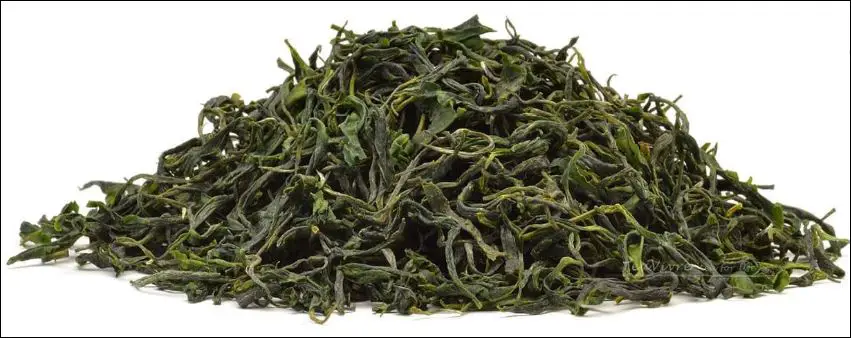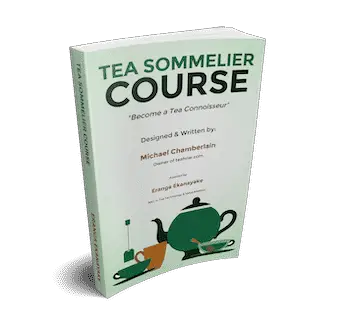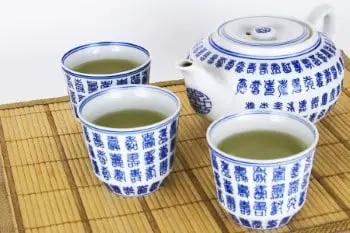Your green tea is bitter? Well, even as an experienced tea drinker, I can sometimes find green tea bitter. So I can fully understand how drinking green tea can put some people off.
And that’s understandable, green tea naturally has a bitter taste, and it’s down to several factors. The quality of green tea, first or second flush, and even the water.
So here I’ve outlined the primary causes that can contribute to this bitter flavor and then I’ll go on to what to do about it. But let’s give you a quick takeaway answer first…
Green tea tastes bitter due to…
- A higher level of Methylxanthines and Catechins
- The date and area of harvest
- A higher Polyphenols content
- Mass production
- Quality of water used for brewing
- The caffeine content
- Brew times increasing tannin content
Here’s how to reduce the bitterness of green tea…
- Use loose-leaf tea: it releases fewer bitter properties
- Steep using cooler water: lower temperature releases less bitterness
- Use fewer loose leaves: A weaker cup is less bitter
- Don’t over-brew: Steep for 2-3 minutes only
- Adding lemon: Lemon adds fragrance to bitter tea
- Drink while it’s hot: hotter green tea yields less bitter flavor
- Add honey: Sweetening combats green tea bitterness
- Add spices: Change the taste by spicing it
- Floral tea: turn your green tea into a floral delight
- Fruit green tea: Make green tea a citrus tea blend
- Make iced tea instead: The bitterness will reduce
- Turn it into a latte: creating a latte blend of green tea
Here’s why your green tea is bitter
With that quick takeaway on why and what to do about it, below is a more in-depth breakdown of the above factors. These are what contribute towards making your green tea bitter.

High levels of methylxanthines and catechins
Methylxanthines are one of the main compounds that contribute to the bitter taste of green tea.
Yeah I know, sounds geeky, but it’s not quite as complex and “sciencey” as that word sounds! Simply put…
This is a category of green tea molecules responsible for giving out natural stimulants in the tea …like caffeine and theobromine.
These compounds also act as a natural pest repellent within the tea plant – before they are harvested.
Catechins are a similar molecule in green tea with a broad range of physiological functions that contribute to the bitter taste in green tea.
Despite the strong bitter flavor that catechins can bring to your green tea, the bitter taste receptors we have for catechins have not yet been fully understood.
Methylxanthines and catechins are the two compounds that effectively contribute towards the weight loss benefit green tea is popularly known for.
So while green naturally can have a rich methylxanthine and catechin profile to facilitate this benefit, it however makes them a primary factor for the bitter flavor.
So next time your green tea is bitter, there’s a good chance it’s contributing even more greatly to your diet! Hopefully, that’s a good thing!
Date and area of harvest
Usually, the harvesting time of green tea leaves is also a contributing factor to the bitter taste in the resulting green tea leaves.
Generally, early spring harvests that are plucked during cold climates will give out a sweeter flavor of green tea.
Tip: A quality tea seller should be able to provide you with some detailed information on your tea. Such as the “flush” of the tea – i.e. when it was picked. And even factors such as which tea plantation, the altitude, and more.
In contrast, as the weather warms, the sweetness levels begin to reduce, increasing the bitter flavor’s intensity.
This is mainly because, in the summer months, the mature leaves of the tea plant will guard themselves with a higher level of bitter flavor to attack the higher number of pests that are around.
It’s also believed that green tea, and in fact, just about any tea grown in low elevations or latitude near the equator (where the climate is more temperate) can yield a higher bitter flavor – compared to teas grown in high elevation and away from the equator.
High polyphenols content
Phenolic compounds in green tea are more commonly associated with astringency rather than bitterness.
However, a higher concentration of phenolic compounds in green tea can further increase the intensity of the astringent flavor, thereby contributing to bitterness.
Also, a high water temperature can yield a much greater astringent and bitter polyphenol content quicker than a long brew using lower-temperature water.
This is because the low temperature can increase the brewing time allowing compounds like highly polymerized Thearubigins to break down, thereby giving out a less bitter flavor.
Water quality
The water used for steeping tea can be an accurate business if you want it to be.
The type of water you use can affect bitterness. Especially tap and distilled water. The different property levels and components in the water can interact with the fragile compounds in green tea. This can cause it to be more bitter and sour than it should be.
As mentioned above, steeping temperature also plays a role in the amount of tannin, polyphenols, and astringency extracted from the tea.
Trying to be overly geeky about tea making can sometimes take the enjoyment out of it though. My Tea Sommelier Course makes becoming the tea connoisseur in your family easy!
Mass production
While tea producers and their professional tea sommeliers pay close attention to the taste of tea to maintain consistency. You can usually expect quality levels to vary. The same goes for the bitterness levels in green tea.
Sometimes, mass-produced tea can produce a more bitter crop than hand-picked tea simply because the machinery is less discerning about the right type and quality of leaves during harvesting.
Caffeine levels
Generally, the greater the caffeine level, the more bitter the taste. This is why strong coffee often has a highly bitter taste. Strong green tea, usually higher quality tea, likely contains a greater amount of caffeine than weaker green tea, therefore will likely have a higher level of bitterness.
Tannin levels
I’ve written an entire article on what you should know about tannin in tea which I’d recommend you check out.
Tannin is effectively the compound known as polyphenols. These provide the strong flavor and astringent properties that you get with tea. Black tea is well known for having a high tannin level, but green tea tannin levels can be even higher, therefore increasing bitterness.
Tannins provide a high bitterness factor. Tannins can be exacerbated by a longer tea steeping process. This allows more tannins to release into the water.
12 simple ways to improve the bitterness in green tea
You should start with how to make green tea to understand the basics, then here I’ve provided 12 things you can do to avoid or improve the bitterness in your green tea.
1. Use loose-leaf tea: it releases fewer bitter properties
Teabags contain dust (or fannings) of green tea which are much smaller particles. These particles have a greater surface area. This means that if you’re using green tea teabags, the bitter properties such as tannins, catechins, and other components are released much faster, and to a greater degree.
One way to combat this is choosing to use loose leaf tea. The surface area is smaller and therefore will yield less of the bitter properties found in tea.
Here’s a good selection of loose leaf green teas to get you started.

2. Steep using cooler water: lower temperature releases less bitterness
As I discussed above, water temperature plays a key role in the release of bitter components.
At boiling temperature, catechins, caffeine, and polyphenols in green tea yield more bitter flavors. Choosing to steep green tea in cooler water not only reduces these but also promotes the release of L-theanine, a component that introduces a lighter, more savory note to the flavor.
And, if you’re steeping green tea anyway, you should not be using boiling water. Especially higher quality green tea. In general, the quality of green tea is greatly reduced by using boiling water. Green tea is steeped at a lower temperature than your standard black tea.
3. Use fewer loose leaves: A weaker cup is less bitter
Naturally, the more leaves you add, the more intense the flavor will be. The same applies here as it would for coffee. Adding 2-3 grams of green loose leaf tea should reduce the bitterness significantly, and still maintain a sufficiently savory green tea flavor.
If you’re using quality green tea, then this also buys into using it sparingly. Meaning more cups of green tea per packet.
Let’s not forget too, that there’s a recommended number of cups per day for most teas, so you might be able to stretch to one extra cup per day by adopting this method.
4. Don’t over-brew: Steep for 2-3 minutes only
Steeping times can get really nerdy. And for beginners, I’d recommend going over my Tea Course before trying to get technical.
In fact, for beginners, you may not be able to discern subtle changes in taste based on slight over-brewing or under-brewing. So learn the basics, and then a good place to start your teas is with these beginner teas.
Then you can start to apply more accurate steeping times to maximize the benefits and yield of your green tea.
Green tea should be steeped for 2-3 minutes. Possibly with a gentle stirring at the mid-way point if you wish. With each subsequent 2nd and 3rd steep, you should add 20 seconds each time to the steep time.
When dealing with sencha, the eastern way provides good results. Steep the first infusion for 1 minute. Your second steep should only last a few seconds.
For the third infusion, steeping time can be longer than one minute. With Chinse green teas, keep the steeping time for the first infusion at around 1 minute, and add 20-30 seconds to each subsequent steep.
5. Adding lemon: Lemon adds fragrance to bitter tea
In a minute I’ll tell you not to let your green tea cool too much, and it may seem counterintuitive, but if you adding lemon that may change slightly.
Adding lemon to green tea can combat the bitter taste, our palette is more comfortable with a lemon flavor than it is with the astringent bitterness of the tea. So adding a slice of lemon alters the flavor profile to make it more palatable. Just let the tea sit for about a minute before adding.
According to my ongoing global tea survey, 21.3% of respondents drank green tea, of all respondents, 2.7% said they added lemon to their tea. I suspect negating bitterness may be part of the reason why this is the case.,
6. Drink while it’s hot: hotter green tea yields less bitter flavor
I’m not suggesting you rush your drink – that would be pointless! And if you’ve added lemon then you’ll need to allow a bit of additional time. But…
Drinking green tea within a few minutes (just steeped) helps to ensure a less bitter flavor. Cooled green tea enables more time for tannins and other properties to generate bitterness. You can check this by looking at the color. If the color seems darker, expect it to be more bitter.
Of course, you want to enjoy your green tea properly, so drinking it within a few minutes should ensure you avoid the build-up of the bitter taste.
7. Add honey: Sweetening combats green tea bitterness
Adding honey can certainly help, and I’d recommend that if you have a slightly sweet tooth, then before giving up green tea then definitely give this a try.
Adding honey to green tea to sweeten it is beneficial overall. You will still gain the benefits of green tea. Honey is a healthier alternative to sugar and provides a better taste than artificial sweeteners. Start by adding a half teaspoon of honey, and increase if the tea still seems bitter.
I’ve written extensively about adding honey to green tea, ideally, it needs to be the right type of honey. I could take the “highbrow” approach that tea should “remain pure”, but I’m no tea snob, and if it means you get the benefits of green tea then I say go for it!
I also have real-world data to add to this, which is that a sample of tea drinkers from my global tea survey stated that honey was an ingredient they added.

Plus, if you’re on a fasting period, then find out if honey will break your fast.
8. Add spices: Change the taste by spicing it
Often people forget they can add other ingredients to their green tea to help remove the bitterness. Green tea can have sharp and harsh notes within the taste. The bitter taste in green tea can be toned down using additional spices.
Adding spices like cardamom, cinnamon, and ginger boosts taste and removes green tea bitterness. Cardamom adds an element of sweetness to the tea, as does cinnamon but with an added citrus notes. Ginger adds a sharp and appetizing taste. Nutmeg and mint also transform the flavor.
9. Floral tea: turn your green tea into a floral delight
You could add one ingredient like mint leaves to help transform your bitter green tea. But why stop there when you can turn your bitter green tea into a floral delight.
To make a more floral-based green tea, a blend of green tea and herbal mix can easily be achieved by adding simple floral ingredients such as rose petals, or peonies. Mint can also be added, as can lavender, jasmine, or chamomile. Simply add as much as desired into the green tea steeping process.
Some of these are of course free if you have them growing in your yard or window box. And aside from enjoying the fragrance of these, adding them to green tea provides another reason to start growing some specific flowering options.
Tip: I’ve also experimented with additional wild herbs and plants that can bring additional benefits, such as dandelion and nettle. Start experimenting with flavors!
10. Fruit green tea: Make green tea a citrus tea blend
In the same way as adding floral elements to your green tea, you can also add more fruity and citrus-type elements, There are quite a few you can try.
To make a fruit-based green tea, aim to add more green, yellow and orange type fruits, such as lemon, lime, peach, pineapple, orange, or mango, or papaya. These will counteract the bitterness and draw it more toward a tangy sweet citrus flavor. Consider adding jams or fruit juices too.
Not only does it help green tea, but it’s also yet another reason to make good use of the fruit in your fruit bowl!
Fruit jams and green tea can actually go really well together, it’s akin to adding honey to green tea. Aim to use smooth-based jams so they melt into the mix, rather than large chunks of fruit jam.
Natural fruit juices are also a good way to inject some citrus into your green tea and will help to change up the flavor. orange, mango, pineapple, papaya, or lemon are all good options. You can consider sugar-free or added sugar options too.
11. Make iced tea instead: The bitterness will reduce
Making iced tea with bitter tea provides greater opportunities to alter the flavor. Here’s a post all about Iced tea.
Reserving green tea that you feel is too bitter to drink to use as an iced tea base means you can add other components. Add ice, and also a sweetening agent all help to alter the taste and reduce the bitterness. Add all the ingredients to your shaker and shake for 60 seconds.
Another similar option is to cold brew your green tea.
To make green tea cold brew, simply steep the green tea as you would normally but with cold water or water at room temperature. Allow it to steep for up to 5 hours in the refrigerator before straining and drinking. Use within 24 hours to avoid the green tea becoming bitter.
12. Turn it into a latte: creating a latte blend of green tea
Latte has usually been associated with coffee, and it can be an option with green tea too. It may seem strange, but it’s one of those drinks that you never know you’ll like unless you try it. And if you like matcha then there’s a fair chance you may like this option!
Standard green tea can be blended into a green tea latte simply by ensuring your steep a strong base using at least twice the number of leaves per 8 oz cup of water. Once you have a strong base, simply add warm milk, and stir. Sweeten to taste.
This is not the same as adding milk to green tea as you might with a standard breakfast tea, that’s something I wouldn’t normally recommend! To sweeten, you can find out about adding sugar to green tea here.
More tea help
I hope this has helped provide a quality answer to the problem that your “Green tea is bitter!”. There are several ways you can improve the taste of green tea without throwing in the towel.
If doing one or more of the above makes your green tea more palatable – dare I say enjoyable! Then I will have helped you enjoy the newfound taste – as well as gain the overwhelming benefits of green tea.
Don’t forget to check out my popular Tea Sommelier course. My course is designed to keep tea learning simple. It will fast-track your tea skills, and make you the go-to tea connoisseur within your circle of friends and family.

Take the fast track and become a tea connoisseur
Whether for enjoyment or considering a career as a tea sommelier. This course has everything you need to enhance your tea knowledge and tea-tasting skills.
This course keeps it simple with step-by-step tea tasting and easy reference guides
For pleasure, or as a precursor to a career in the tea industry. Find out what tea sommelier actually does, their career paths, and what they earn.

Find out more about the Teahow Tea Sommelier Course!

